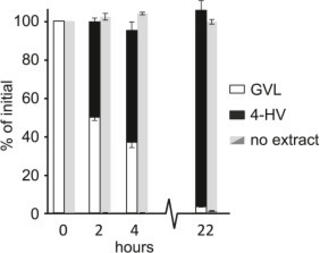A broad specificity β-propeller enzyme from Rhodopseudomonas palustris that hydrolyzes many lactones including γ-valerolactone
B.W. Hall et al. "A broad specificity β-propeller enzyme from Rhodopseudomonas palustris that hydrolyzes many lactones including γ-valerolactone" Journal of Biological Chemistry 1 (2023) [DOI: 10.1016/j.jbc.2022.102782]
Lactones are prevalent in biological and industrial settings, yet there is a lack of information regarding enzymes used to metabolize these compounds. One compound, γ-valerolactone (GVL), is used as a solvent to dissolve plant cell walls into sugars and aromatic molecules for subsequent microbial conversion to fuels and chemicals. Despite the promise of GVL as a renewable solvent for biomass deconstruction, residual GVL can be toxic to microbial fermentation. Here, we identified a Ca2+-dependent enzyme from Rhodopseudomonas palustris (Rpa3624) and showed that it can hydrolyze aliphatic and aromatic lactones and esters, including GVL. Maximum-likelihood phylogenetic analysis of other related lactonases with experimentally determined substrate preferences shows that Rpa3624 separates by sequence motifs into a subclade with preference for hydrophobic substrates. Additionally, we solved crystal structures of this β-propeller enzyme separately with either phosphate, an inhibitor, or a mixture of GVL and products to define an active site where calcium-bound water and calcium-bound aspartic and glutamic acid residues make close contact with substrate and product. Our kinetic characterization of WT and mutant enzymes combined with structural insights inform a reaction mechanism that centers around activation of a calcium-bound water molecule promoted by general base catalysis and close contacts with substrate and a potential intermediate. Similarity of Rpa3624 with other β-propeller lactonases suggests this mechanism may be relevant for other members of this emerging class of versatile catalysts.
The atomic coordinates and structure factors (codes 7RIS, 7RIZ, 8DK0, 8DJF, 8DJZ) have been deposited in the Protein Data Bank. Frame data has been deposited in the Protein Diffraction database.
